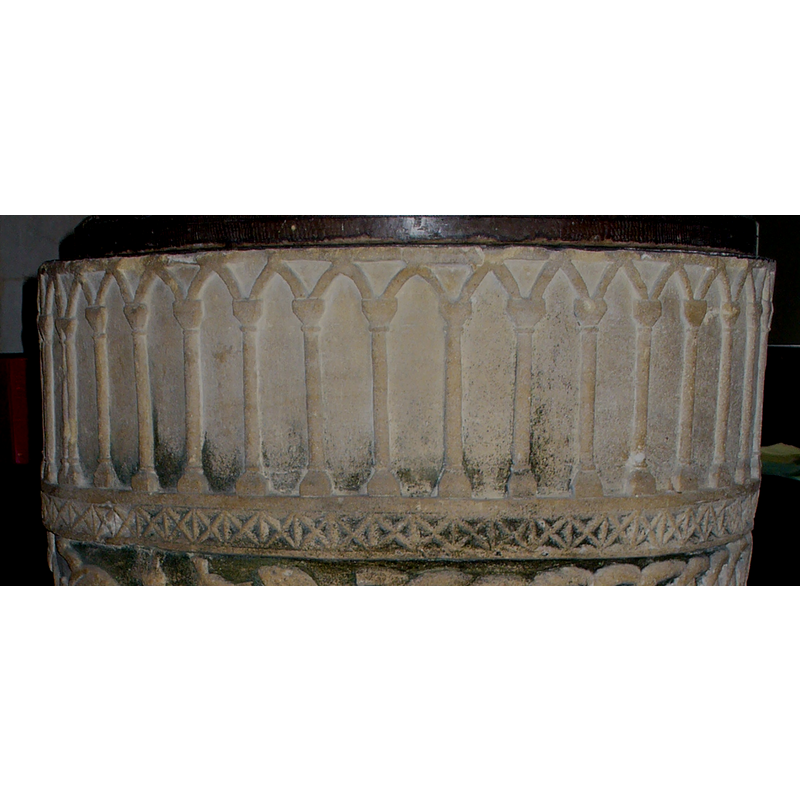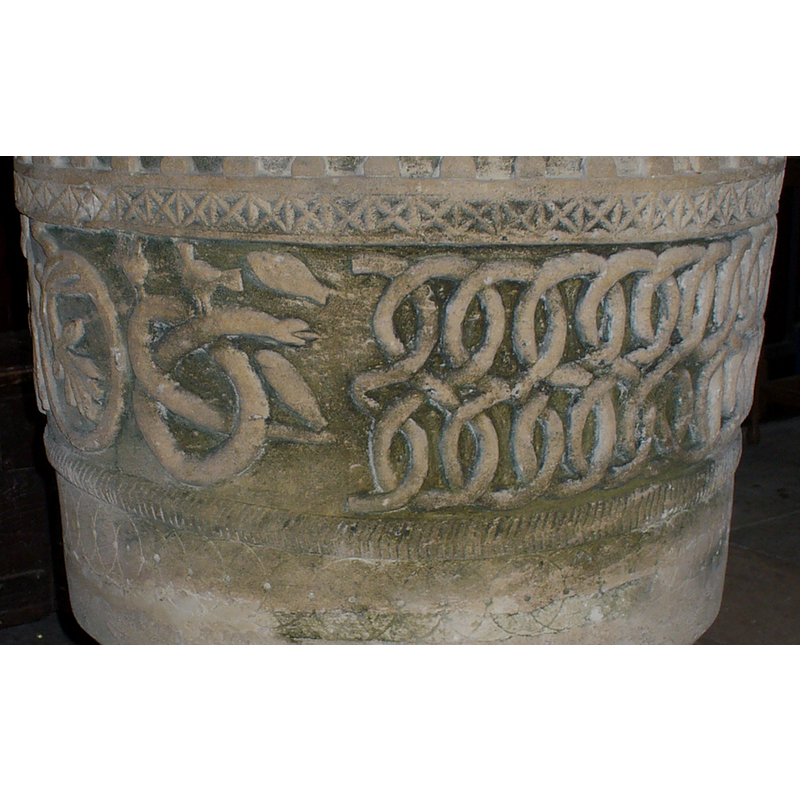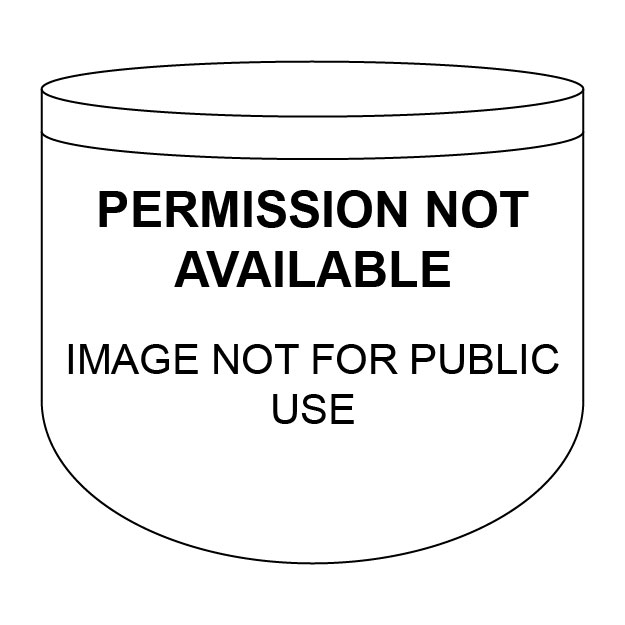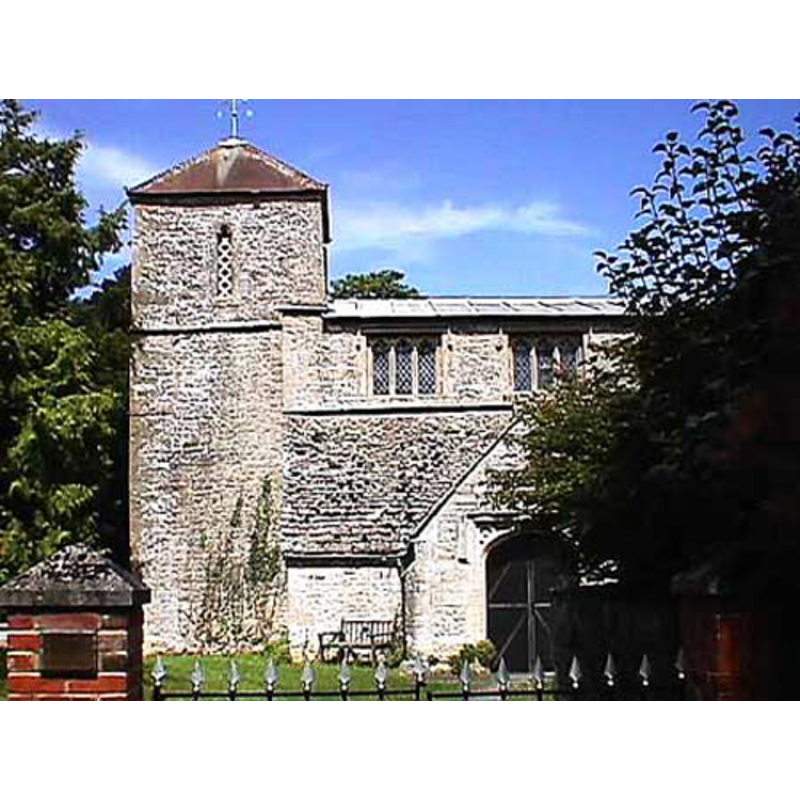Hinton Parva / Little Hinton

Image copyright © John Wilkes, 2004
Standing permission
Results: 13 records
B1R01: design element - architectural - arcade - round arches - intersecting arches
B1R02: design element - motifs - geometric
Scene Description: a thin band of X-inside-a-rectangle, all around the middle of the basin side
Copyright Statement: Image copyright © Colin Smith, 2008
Image Source: detail of a digital photograph by Colin Smith, May 2008
Copyright Instructions: Image and permission received (e-mail of 25 May 2008)
B2R01: animal - fish - 2
B2R02: animal - reptile - snake - coiled
B2R03: animal - bird - dove - facing each other - 2
B2R05: design element - motifs - foliage - acanthus
B2R06: design element - motifs - interlace
B2R07: design element - motifs - rope moulding?
view of basin - detail
Scene Description: a detail of the lower register of the basin: a knotted serpent with birds and fishes
Copyright Statement: Image copyright © Giles C. Watson, 2007
Image Source: digital photograph taken 7 May 2007 by Giles C. Watson; in FLICKR [http://flickr.com/photos/29320962@N07/2991864588/in/pool-fonts] [accessed 13 November 2008]
Copyright Instructions: PERMISSION NOT AVAILABLE -- IMAGE NOT FOR PUBLIC USE
view of basin - detail
view of church exterior - south view
view of font
INFORMATION
FontID: 02491HIN
Object Type: Baptismal Font1
Church/Chapel: Parish Church of St. Swithun
Church Patron Saints: St. Swithun [aka Swithin]
Church Location: Church Row, Hinton Parva, Wiltshire, SN4 0DW
Country Name: England
Location: Wiltshire, South West
Directions to Site: Hinton Parva is just E of Swindon [NB: not to be mistaken with Hinton Parva, aka Stanbridge, in nearby Dorset, with a Victorian church dedicated to St. Kenelm]
Ecclesiastic Region: Diocese of Bristol
Historical Region: Hundred of Elstub and Everleigh
Font Location in Church: Inside the church
Century and Period: 11th - 12th century [partly re-cut?] [composite font - restored], Medieval / composite
Cognate Fonts: The font at Black Bourton, in Oxfordshire, is of the same type
Credit and Acknowledgements: We are grateful to Colin Smith, and to John Wilkes, of www.allthecotswolds.com, for their photographs of this font and church.
Font Notes:
Click to view
No individual entry found for Hinton Parva in the Domesday survey. Font described in Scarth (1883-1884) with date ca. 1100. Noted in Ponting (1899): "The font is a very remarkable one. The bowl is a circular one apparently reduced in height; round the upper part is carried a flat and rude arcade with double shafts having cushion capitals, and arches formed of two straight lines, as found in Saxon structures; this arcade rests on a band of diaper-work. Below this is a band of rudely-carved subjects representing:-- A serpent with two birds standing on it and two fishes near. A scroll of early foliated carving projecting from the mouth of an animal. A stag ascending a vertical pole with a goose standing behind. The remainder of the space is filled with a curious interlaced pattern, circular in section and of a pattern resembling the figure 8 repeated. Below this comes a cable-mould and under it a band of roughly-incised intersecting circles. The bowl has been re-faced, but the design has doubtless been more or less correctly preserved. It rests on an old circular shaft with splayed plinth and cap." [NB: this entry is commented by the editor of the Wiltshire Magazine in a footnote: "I recollect being told many years ago by the then Rector, the Rev. J. Smith, that the surface of the font had been re-cut at the time of the restoration of the Church, and that 'most unfortunately' the masons had altered the original form of the arcading. If this was so, it would account for its present curious form, and might modify opinion as to the very early date of the font".] Described in Tyrrell-Green (1928) as a baptismal font of the Norman period in which "the bowl is supported not directly by the base upon which it is mounted, but there intervenes a short cylindrical shaft to carry the bowl"; he gives the font at Black Bourton, in Oxfordshire, as being of the same type. Tyrrell-Green (ibid.) describes "a serpent [...] depicted [...] with birds (doves) and fishes symbolising the conflict between Christian souls and the power of evil"; he also mentions an arcade on the basin side (ibid.) Buck (1951) reviews the different comments on this font made through the years (noting Ponting, Tyrrell-Green, etc., but also pointing out its absence in Paley, Bond, Wall and Cox & Harvey. Buck (ibid.) makes his own conclusions: 1)that the font is made up of two kinds of stone: oolite for most of the basin, and local chalk for the rest; 2)that the whole font was originally made of the local chalk stone, but the basin cracked from freezing of the water, and was replaced by the oolite, a harder limestone; 3)that the fragments of the old basin were used to make a close copy on the new stone; 4)that there are no cover fastenings on the upper rim, and that this may be an indication the rim was trimmed off at some point; 5)that the star and fishbone motifs on the font date from the 12th century; 6)that although some of the motifs and patterns in the lower band of decoration have been described as Saxon or Celtic, the presence of the figure eight, the "irregular convolutions of serpents" and the grotesque quadruped, make this "a Norman type of ornament"; 7)the foliated scroll lower down should be dated later than the one on the Castle Eaton font [i.e., later than 1160-1170], and that the serpent tying itself in a knot, with the two birds and two fishes, "is a Norman allegorical design symbolic of the Christian life; 8)"This font, therefore, is considered to be not earlier than twelfth century as regards the lower portion, the upper portion being of uncertain later date and probably based, more or less, on the original design". Noted in Pevsner & Cherry (1975): "Font. Circular, Norman, with one band of arcading and one partly of wild knotwork, partly with animals in a disorderly arrangement: a twisted snake with two birds pecking at it and two fishes near by, a quadruped seemingly seating on its behind, and in fact a bird." The basin has not only two registers of decoration, one above the other, but some of the patterns change from back to front; the interlace on one side changes and then stops altogether for the carvings of the animals. The Victoria County History (Wiltshire, vol. 11, 1980) notes: "in 1172 the bishop of Winchester confirmed St. Swithun's Priory as patron of Hinton church [...] he nave is earlier than its arcades. Of those, which are of two bays with long spans, that to the south is of the later 12th century and that to the north of the earlier 13th century. [...] The stem and base of the font are probably of the later 12th century. The bowl, on which various birds and animals are depicted, is possibly of later date. It was much restored c. 1860." Noted and partially illustrated in Tisdall (1998?) with his usual far-fetched interpretations. The sides show between a band of geometric design [X in squares] at the top and a parallel band of rope motif at the bottom; on the upper register an arcade of intersecting arches all around [NB: the upper rim seems to have been trimmed, which would account for the upper part of the arcade not being visible; below, a number of motifs which include, from right to left, an intricate braided and interlaced pattern which stops with open ends; a large coiled serpent facing right; underneath it, a fish; another above; two doves (?) rest on the upper coil of the serpent; at the extreme left an acanthus (?) leaf inscribed in a circle; the cylindrical stem is plain, as is the round lower base.
COORDINATES
UTM: 30U 592317 5711604
MEDIUM AND MEASUREMENTS
Material: stone, type unknown
Font Shape: bucket-shaped (mounted)
Basin Interior Shape: round
Basin Exterior Shape: round
LID INFORMATION
Date: modern
Material: wood
Apparatus: no
Notes: flat, with metal handle and ornamentation
REFERENCES
Victoria County History [online], University of London, 1993-. Accessed: 2012-01-27 00:00:00. URL: https://www.british-history.ac.uk.
Buck, A.G. Randle, "Some Wiltshire fonts. Part II", LIV, CXCIV (June 1951), The Wiltshire Archaeological and Natural History Magazine, 1951, pp. 19-35; p. 21-23, 25 and pl. I.19, 20
Cox, John Charles, Nottinghamshire, London: Allen, 1912
Ponting, C.E., "Notes on churches visited in 1898", XXX, XCI, The Wiltshire Archaeological and Natural History Magazine, 1899, pp. 169-197; p. 197 and fn 1
Scarth, H.M., "Font at Hinton Parva, Gloucestershire", 8, Transactions of the Bristol and Gloucestershire Archaeological Society, 1883-1884, pp. 153-155; p. 153-155 / [http://www2.glos.ac.uk/bgas/tbgas/v005/bg008153.pdf] [accessed 27 February 2009]
Tisdall, M. W., God's beasts: identify and understand animals in church carvings, England: Charlesfort Press, 1998?
Tyrrell-Green, E., Baptismal Fonts Classified and Illustrated, London: Society for Promoting Christian Knowledge: The Macmillan Co., 1928



